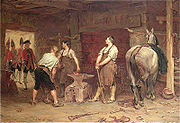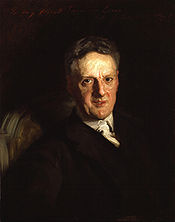
John Seymour Lucas
Encyclopedia

History painting
History painting is a genre in painting defined by subject matter rather than an artistic style, depicting a moment in a narrative story, rather than a static subject such as a portrait...
and portrait painter as well as an accomplished theatrical costume designer. He was born into an artistic London family, and originally trained as a woodcarver, but turned his attention to portrait painting and entered first the St. Martin's Lane Art School and later the Royal Academy
Royal Academy
The Royal Academy of Arts is an art institution based in Burlington House on Piccadilly, London. The Royal Academy of Arts has a unique position in being an independent, privately funded institution led by eminent artists and architects whose purpose is to promote the creation, enjoyment and...
Schools. Here he met his French wife, fellow artist Marie Cornelissen, whom he married in 1877. Lucas’ artistic education included extensive travels around Europe, particularly Holland and Spain, where he studied the Flemish and Spanish Masters. He first started exhibiting in 1872, was elected an associate member of the Royal Academy in 1876 and a full Royal Academician in 1898.
Biography and work
John Seymour Lucas was first and foremost a historical genre painter with a particular talent for realism in the depiction of costumes and interiors. Inspired by van Dyck and particularly Diego VelázquezDiego Velázquez
Diego Rodríguez de Silva y Velázquez was a Spanish painter who was the leading artist in the court of King Philip IV. He was an individualistic artist of the contemporary Baroque period, important as a portrait artist...
, he excelled in depicting scenes from the English 16th to 18th century Tudor
Tudor period
The Tudor period usually refers to the period between 1485 and 1603, specifically in relation to the history of England. This coincides with the rule of the Tudor dynasty in England whose first monarch was Henry VII...
and Stuart
Stuart period
The Stuart period of English and British history refers to the period between 1603 and 1714, while in Scotland it begins in 1371. These dates coincide with the rule of the Scottish royal House of Stuart, whose first monarch to rule England was James I & VI...
periods, including in particular the Spanish Armada
Spanish Armada
This article refers to the Battle of Gravelines, for the modern navy of Spain, see Spanish NavyThe Spanish Armada was the Spanish fleet that sailed against England under the command of the Duke of Medina Sidonia in 1588, with the intention of overthrowing Elizabeth I of England to stop English...
, Preparing for the Voyage, the English Civil War
English Civil War
The English Civil War was a series of armed conflicts and political machinations between Parliamentarians and Royalists...
and the Jacobite rebellions.
His first major work to achieve widespread public acclaim was Rebel Hunting after Culloden
Culloden
Culloden may refer to any of the following:*Culloden, Highland, a village in Scotland**The Battle of Culloden, a battle which took place there in 1746...
, executed in 1884. It was praised not only for the obvious tension between the muscular blacksmiths and the redcoated forces of law and order (or repression) but for the extraordinary realism in the depiction of the rough smithy and glowing horsehoe on the anvil.
In 1885 his next major work whas "Preparing for the Voyage".

John Singer Sargent
John Singer Sargent was an American artist, considered the "leading portrait painter of his generation" for his evocations of Edwardian era luxury. During his career, he created roughly 900 oil paintings and more than 2,000 watercolors, as well as countless sketches and charcoal drawings...
who was his almost exact contemporary. A portrait of Lucas executed by John Singer Sargent is displayed in Tate Britain
Tate Britain
Tate Britain is an art gallery situated on Millbank in London, and part of the Tate gallery network in Britain, with Tate Modern, Tate Liverpool and Tate St Ives. It is the oldest gallery in the network, opening in 1897. It houses a substantial collection of the works of J. M. W. Turner.-History:It...
. Towards the 1890s John Seymour Lucas executed a number of major works for prestigious public buildings or royal clients. These include: The Flight of the Five Members (Houses of Parliament), The Granting of the Charter of the City of London (Royal Exchange), Reception by HM King Edward VII of the Moorish Ambassador (Royal Collection
Royal Collection
The Royal Collection is the art collection of the British Royal Family. It is property of the monarch as sovereign, but is held in trust for her successors and the nation. It contains over 7,000 paintings, 40,000 watercolours and drawings, and about 150,000 old master prints, as well as historical...
), HRH the Prince of Wales in German Uniform (Royal Collection)
Apart from executing over 100 major oil paintings and a host of drawings, Lucas was renowned as a set and costume designer for the historical dramas popular on the late Victorian and early Edwardian stages. One of his more unusual commissions was the "Duke of Normandy" costume for the ill-fated prince Alfred of Saxe Coburg-Gotha for the Devonshire House
Devonshire House
Devonshire House in Piccadilly was the London residence of the Dukes of Devonshire in the 18th and 19th centuries. It was built for William Cavendish, 3rd Duke of Devonshire in the Palladian style, to designs by William Kent...
Ball in 1897. Lucas was also a prolific watercolour painter and was elected a member of the Institute of Painters in Water Colours
Royal Institute of Painters in Water Colours
The Royal Institute of Painters in Water Colours , initially called the New Society of Painters in Water Colours, , is one of the societies in the Federation of British Artists, based in the Mall Galleries in London.-History:In 1831 the society was founded as the New Society of Painters in Water...
in 1877.
During most of his artistic career, John Seymour Lucas lived in a purpose-built studio in South Hampstead
South Hampstead
South Hampstead is a district of northwest London, part of the London Borough of Camden. It could be defined as the area between West End Lane, Belsize Road, Finchley Road and Broadhurst Gardens, although the area is largely indistinguishable from the nearby Swiss Cottage.-Nearby places:* Hampstead...
, London, designed for him by his friend and fellow artist, architect Sydney Williams-Lee.
He retired from painting towards the end of World War I, and moved to Blythburgh
Blythburgh
Blythburgh is a small English village in an area known as the Sandlings, part of the Suffolk heritage coast. Located close to an area of flooded marshland and mud-flats, in 2007 its population was estimated to be 300. Blythburgh is best known for its church, Holy Trinity, internationally known as...
, Suffolk, where re-designed a house next to the church known as 'The Priory'. Lucas died in 1923 and is interred in Blythburgh church yard. His son, Sydney Seymour Lucas, was also an artist, and illustrator.
Legacy
John Seymour Lucas was a renowned artist in his day, when his painting style and themes resonated with the core themes of Imperial Great Britain: the uniqueness of the English historical experience and its seemingly inexorable rise to global preeminence. Furthermore, his love for colourful detail, veracity and the theatrical was well suited to the tastes of the late Victorian audience. However, the end of Pax BritannicaPax Britannica
Pax Britannica was the period of relative peace in Europe when the British Empire controlled most of the key maritime trade routes and enjoyed unchallenged sea power...
and the rise of Modernism
Modernism
Modernism, in its broadest definition, is modern thought, character, or practice. More specifically, the term describes the modernist movement, its set of cultural tendencies and array of associated cultural movements, originally arising from wide-scale and far-reaching changes to Western society...
left these twin pillars of John Seymour Lucas oeuvre slightly marooned and he is less than a household name today. Nevertheless, he has left a unique legacy as a chronicler of English history and a costume painter of distinction.

